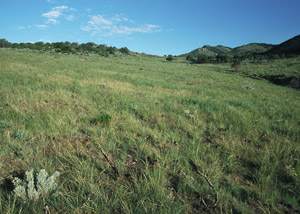August 2014
 Pasture leases can be a tricky business or a great opportunity for both the land and livestock owners. Pat Reece, professor emeritus and now a consultant and owner of Prairie and Montane Enterprises, understands this from years of experience working with producers. Dr. Reece recently recorded a webinar "Equitable Incentives for Land and Livestock Owners" that highlights these incentives.
Pasture leases can be a tricky business or a great opportunity for both the land and livestock owners. Pat Reece, professor emeritus and now a consultant and owner of Prairie and Montane Enterprises, understands this from years of experience working with producers. Dr. Reece recently recorded a webinar "Equitable Incentives for Land and Livestock Owners" that highlights these incentives.
Lease agreements should always benefit the rangeland resources. "It is in the best interest of the land and livestock owner to improve and maintain range condition," states Reece.
Landowners can provide incentives for grazers in a lease. First, the landowner must realize the potential herbage production of their rangeland. A trusted rancher, Extension staff, or NRCS staff can advise the landowner.
How do you start improving the rangeland resource?
- Start with a moderate stocking rate that matches your pasture condition. The NRCS has stocking rates for a variety of range sites and condition.
- Graze semi-arid pastures one time per year and vary the time pastures are grazed from year to year.
- Subirrigated meadows may be grazed two or more times during the year, because of their plentiful soil moisture.
- Base the lease on Animal Units, or how much grass is available to graze. This allows flexibility as production changes from year to year.
- Plan to adjust stocking rates for dry and wet years to match livestock forage demand to available herbage production.
Land owners should consider rewarding good management practices by the livestock owner through deferred compensation. Management activities that could be rewarded with deferred compensation to the livestock owner could include the following.
- Rewarding good grazing management. Management practices that will increase herbage production and the land value for the land owner.
- Labor and materials the livestock owner provides. Is the livestock owner fixing the fence or wells? What would it cost to hire someone to do these activities?
- Years of labor or for other inputs that have been provided without full compensation. An example here may be in the settling of an estate or for the rewarding of long term efforts by a livestock owner.
Example of Deferred Compensation could include any of the following.
- Shift from a one-year lease to a multiple-year lease. The long term lease should include periodic adjustments, especially for stocking rate.
- Discount the base price of forage, or hold the price steady.
- Include the first-right-of-refusal clause in the lease.
- Include the first-right-of-refusal contract for the purchase of a specified land parcel.
- Add a percent discount on the future appraised value of the property in the first-right-of-refusal contract.
- Families passing the ranch to the next generation could include the future receipt of the title for a specified parcel of land at a specified date or event in the life of the land owner.
Remember to work with an attorney to draw up these arrangements, so it will be legal and binding.
Bethany Johnston
UNL Extension Educator
Central Sandhills
University of Nebraska